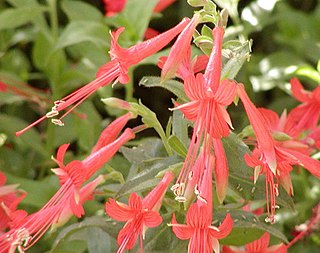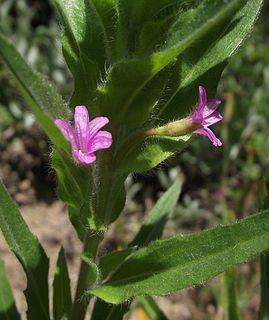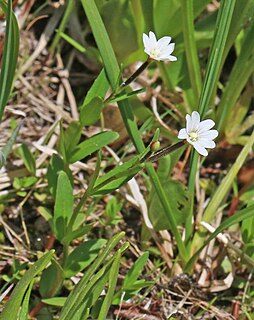
Epilobium canum, also known as California fuchsia or Zauschneria, is a species of willowherb in the evening primrose family (Onagraceae). It is native to dry slopes and in chaparral of western North America, especially California. It is a perennial plant, notable for the profusion of bright scarlet flowers in late summer and autumn.

Epilobium anagallidifolium is a species of willowherb known by the common names pimpernel willowherb and alpine willowherb. This small flowering plant has a near-circumboreal distribution and can be found in mountain ranges further south, where grows in alpine climates. It is a perennial found in low clumps rarely exceeding 20 centimeters in height.

Epilobium brachycarpum is a species of willowherb known by the common names tall willowherb, tall annual willowherb, panicled willowherb and tall fireweed. It is native to and widespread in North America, where it is a resident of varied open and woodland habitats. It has also been introduced to some areas in South America. This is a tall glandular, hairy annual herb occasionally reaching two metres in height. It is somewhat gangly and thin like an erect weed, with narrow, curving, pointed leaves up to a few centimetres in length. The flower has four petals which may be so deeply notched that they look like four pairs. They are generally light purple or pink, with darker veining. The fruit is a capsule 1 to 3 centimetres long.

Epilobium ciliatum, known by the common names fringed willowherb, American willowherb, slender willow herb, and northern willow herb is a species of flowering plant in the willowherb family Onagraceae. This species is native to much of North America, southern South America, and East Asia. It is an introduced species in much of Eurasia and Australia.
Epilobium cleistogamum is a species of willowherb known by the common name selfing willowherb. This plant is endemic to central California where it is a resident of vernal pools and mudflats. It is a small annual plant with fuzzy pointed green leaves. Some of the leaves have hairs which are knobby and gland-tipped. The flowers are usually cleistogamous, that is, they self-pollinate without opening. Some of the flowers do open to reveal pinkish-purple to nearly white, deeply notched petals. The fruit is a tough four-sided capsule about a centimeter long.

Epilobium densiflorum is a species of willowherb known by the common names denseflower willowherb, dense spike-primrose or dense boisduvalia. It is native to western North America from British Columbia to Baja California, where it is found in a variety of habitats. This is an erect annual often exceeding a meter in height with fuzzy green foliage. The pointed leaves are up to 8 centimeters long near the base of the plant, and the upper leaves are generally more hairy than the lower. The stem may branch or not. The top of the stem is occupied by a hairy, leafy, densely flowered inflorescence. Each flower has four deeply notched petals in shades of pinkish purple to nearly white with dark veining, each about a centimeter long. The fruit is a cylindrical capsule about a centimeter long.

Epilobium glaberrimum is a species of willowherb known by the common name glaucous willowherb. This clumping perennial wildflower is native to western North America from central Canada to northern Mexico. It generally grows at some elevation in moist places. This plant is somewhat variable in appearance. It may exceed half a meter in height and has hairless foliage with leaves between one and 8 centimeters long. The flower has four notched petals in purple, pink, or white which may be only a couple of millimeters long to over a centimeter long each. The fruit is a narrow, sticklike capsule 2 to 7 centimeters long.

Epilobium lactiflorum is a species of willowherb known by the common name milkflower willowherb or whiteflower willowherb. This plant is found throughout northern North America and northern Eurasia, where it most often grows in moist, rocky areas at some elevation. It is a hairy, clumping perennial with thin stems reaching 10 to 50 centimeters in height, and leafy stolons. The leaves are 2 to 5 centimeters long and have hairs along the edges and winged petioles. The tiny flowers are usually white, sometimes pink, and have notched petals 3 to 6 millimeters long. The fruit is a hairy capsule up to 10 centimeters in length.

Epilobium minutum is a species of willowherb known by the common names little willowherb, chaparral willowherb and desert willowherb. It is also called "smallflower willowherb" in reference to its small size relatively. However that name, in particular the British English variant "small-flowered willowherb", typically refers to Epilobium parviflorum.

Epilobium obcordatum is a species of perennial plant in the evening-primrose family (Onagraceae), known by the common name rockfringe willowherb and rock fringe. It is native to the western United States from California to Idaho, where it is found in rocky mountainous areas, at altitudes of 7,000 ft (2,100 m) to 13,000 ft (4,000 m). This small perennial is clumpy to mat-forming and spreads from a woody caudex, especially in nooks between rocks. It has stems lined with oval or rounded leaves which spread parallel to the ground or ascend somewhat. At the tips of the thin stems are flowers each with four petals. The petals are magenta to purple, rounded and notched, often in a perfect heart shape, and are one or two centimeters long. The glandular, club-like, ridged fruit is a capsule two to four centimeters long growing on a short stalk.

Epilobium clavatum is a species of flowering plant in the evening primrose family known by the common names talus willowherb and clavatefruit willowherb. It is native to western North America from Alaska to northern California to Colorado, where it grows in rocky high mountain habitat such as talus. It is a clumping perennial herb forming bristly mounds up to about 20 centimeters high and spreading outward via tough stolons. The oval-shaped leaves are 1 to 3 centimeters long. The inflorescence is an erect raceme of flowers, each with four small pink petals. The fruit is a capsule up to 4 centimeters long.
Epilobium foliosum is a species of flowering plant in the evening primrose family known by the common names leafy willowherb and California willowherb. It is native to parts of western North America from British Columbia through California to Arizona, where it grows in many types of habitat, including disturbed areas.
Epilobium halleanum is a species of flowering plant in the evening primrose family known by the common name glandular willowherb. It is native to parts of western North America from British Columbia to New Mexico, where it grows in many types of habitat. It is an erect perennial herb growing up to about half a meter tall. The leaves are oval in shape low on the stem and narrower and somewhat lance-shaped higher, the longest about 4.5 centimeters long. The inflorescence is a raceme of glandular flowers, each with four notched white to pink petals a few millimeters long. The fruit is an elongated capsule up to 6 centimeters long.
Epilobium howellii is an uncommon species of flowering plant in the evening primrose family known by the common names Yuba Pass willowherb and subalpine fireweed. It is endemic to the High Sierra Nevada of California, where it is known from only about 20 occurrences.

Epilobium leptophyllum is a species of flowering plant in the evening primrose family known by the common names bog willowherb and linear-leaved willowherb. It is native to much of eastern and northern North America, where it grows in moist areas, such as bogs. It is a perennial herb growing up to a meter tall and spreading with tiny stolons. The leaves are generally linear in shape but may be wider to nearly oval, and reach up to about 7.5 centimeters. The inflorescence is a raceme of small flowers with white to pink petals a few millimeters long. The fruit is a hairy, elongated capsule up to 8 centimeters in length.

Epilobium oreganum is an uncommon species of flowering plant in the evening primrose family known by the common names Grants Pass willowherb and Oregon fireweed. It is native to southern Oregon and northern California, where it is historically known mostly from the Klamath Mountains. It is currently confirmed to exist only in Josephine County, Oregon, and Trinity County, California, where it grows in boggy areas on serpentine soils. It is a perennial herb growing up to a meter in height with thin, hairless stems. The red-veined leaves are oval to lance-shaped and up to 9 centimeters long. The inflorescence bears flowers with pink petals just over a centimeter long and a protruding pistil. The fruit is a hairy, glandular capsule up to 4.5 centimeters long.

Epilobium oregonense is a species of flowering plant in the evening primrose family known by the common name Oregon willowherb. It is native to western North America from British Columbia to Arizona, where it generally grows in moist places in several types of habitat. It is a perennial herb growing spindly erect stems approaching 40 centimeters high or sometimes forming mats spreading via stolons. The small leaves are rounded near the base of the plant and linear in shape farther up the stem. The inflorescence bears flowers with four white to pink petals each a few millimeters long. The fruit is an elongated capsule up to 5 centimeters in length which is borne on a long pedicel which may be longer than the capsule itself.
Epilobium rigidum is an uncommon species of flowering plant in the evening primrose family known by the common names stiff willowherb and Siskiyou Mountains willowherb.

Epilobium siskiyouense is a rare species of flowering plant in the evening primrose family known by the common names Siskiyou willowherb and Siskiyou fireweed.
Epilobium torreyi is a species of flowering plant in the evening primrose family known by the common names Torrey's willowherb and brook spike-primrose. It is native to western North America from British Columbia to California, where it grows in many types of habitat, often in moist areas. It is a hairy annual herb producing a narrow, upright stem often exceeding half a meter tall lined with narrow lance-shaped leaves. The hairy, glandular inflorescence bears tiny white or pink flowers. They are usually cleistogamous, remaining closed and self-pollinating. The fruit is a capsule up to about a centimeter long.














